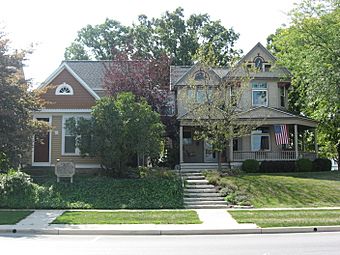Dr. Issac Elmer Williams House and Office facts for kids
Quick facts for kids |
|
|
Dr. Issac Elmer Williams House And Office
|
|

Streetside view of the house (right) and the office (left)
|
|
| Location | 407-411 N. Main St., St. Marys, Ohio |
|---|---|
| Area | 0.5 acres (0.20 ha) |
| Built | 1903 |
| Architectural style | Queen Anne |
| NRHP reference No. | 79001785 |
| Added to NRHP | May 8, 1979 |
The Dr. Issac Elmer Williams House and Office are two historic buildings in St. Marys, Ohio, United States. Built in 1903, they are great examples of the Queen Anne style of architecture.
Contents
Who Was Dr. Issac Elmer Williams?
Dr. Issac Elmer Williams was a doctor who started practicing medicine in St. Marys, Ohio, in 1892. He had just graduated from the Kentucky School of Medicine at the University of Louisville. He worked as a doctor in St. Marys for a long time, until he retired in 1942.
A Doctor's Home and Office
In 1903, Dr. Williams built his house and his doctor's office right next to each other. This was a common setup for doctors in smaller towns back in the early 1900s. It was convenient for them to live and work in the same place or very close by.
Both buildings are made of wood and show off the popular Queen Anne architectural style of that time.
What Does Queen Anne Style Look Like?
The Queen Anne style is known for its unique and often fancy details. The Dr. Williams house has a large roof with many gables. Gables are the triangular parts of a wall that support a pitched roof. The most noticeable gables are in the attic, and they have special imbricated shingles. These shingles are laid in a way that makes them look like fish scales.
The office building is located just south of the house. It's a single-story building with five rooms. Its design is very similar to the house, even having an attic gable with those same imbricated shingles.
A Place in History
In 1979, both the Dr. Issac Elmer Williams House and Office were added to the National Register of Historic Places. This means they are recognized as important historical sites. They were chosen for this honor for two main reasons:
- They tell us a lot about the local history of St. Marys.
- They are excellent examples of Queen Anne architecture.
What makes them so special is that very few changes have been made to either building, inside or out. This means they still look much like they did when they were built over 100 years ago. Their side-by-side location also makes them a great example of how a doctor's home and office were set up in the early 20th century.



